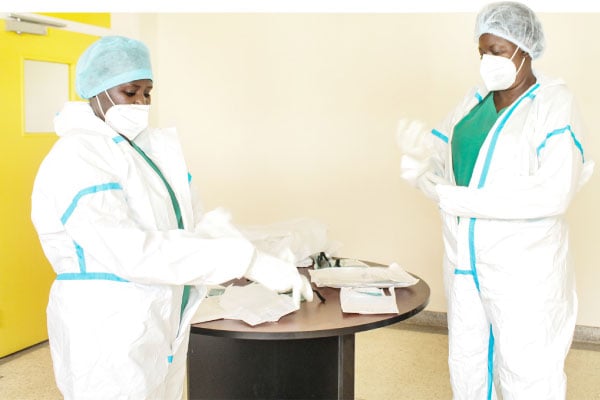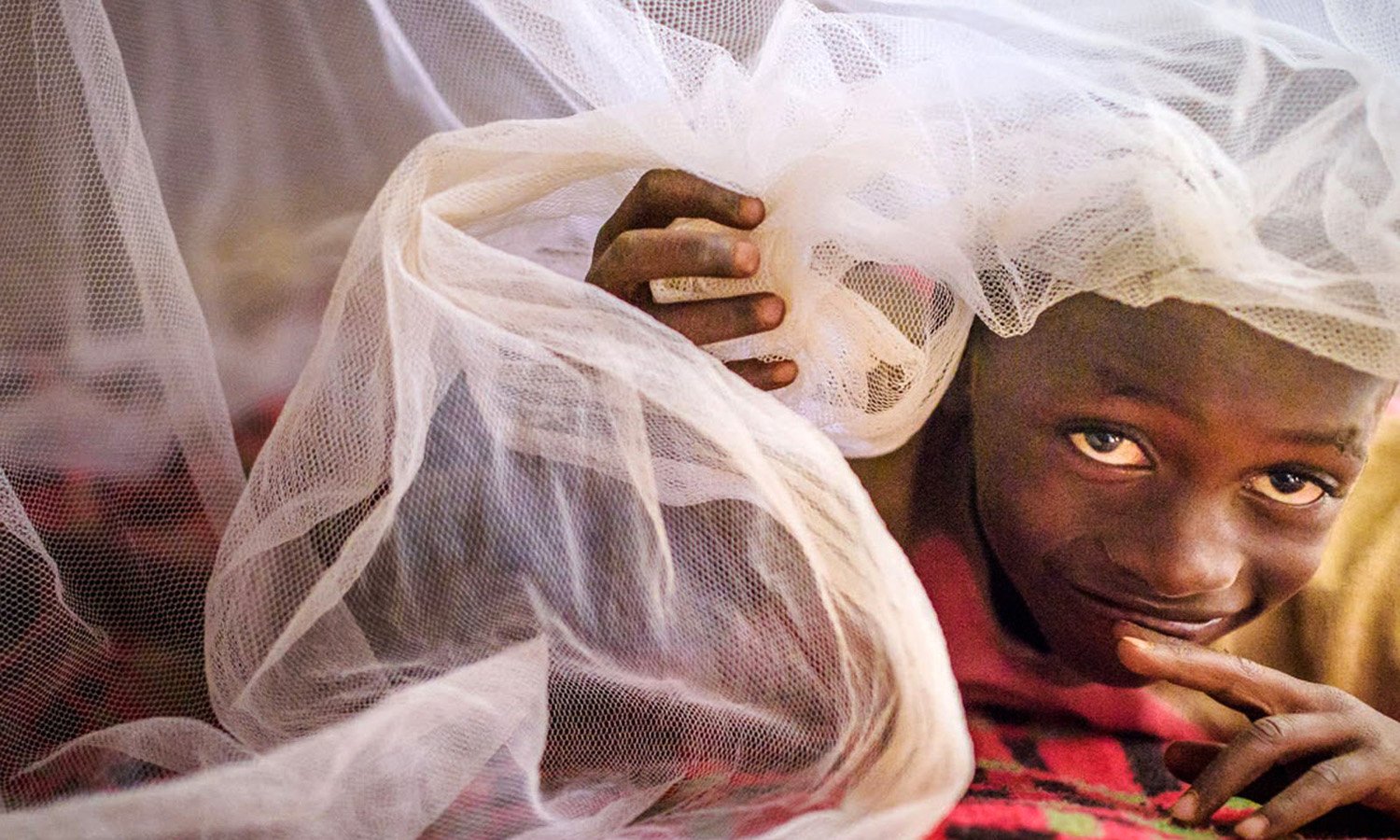Nurses’ story of anxiety, love in treating Covid-19 patients

Ms Jane Rose Naafa (left) and Ms Lilian Grace Achen wear Personal Protective Equipment before entering the ward where Covid-19 patients were isolated at Mulago National Specialised Hospital in Kampala on May 6. PHOTO BY KELVIN ATUHAIRE
Health workers such as nurses and doctors are trained not to show emotion when treating people with various ailments.
Even when one of their patients die, hardly will the health workers shed a tear amid the wailing relatives and friends.
But since the first case of coronavirus was confirmed in Uganda on March 21, health workers, specifically the nurses, who have been treating the patients, narrate that their professionalism faced a stern test.
“We were seeing how other colleagues in other countries were working day and night and how some were dying there. We first got scared. Some of the patients here were watching what was happening in other countries and they had a lot of fear,” Ms Bernadette Namugema, a nurse who has been treating Covid-19 patients at Mulago National Specialised Hospital, reveals.
Mulago admitted its first case on March 24 and the numbers increased to 22 in the next three weeks.
Being a new disease under research, Ms Namugema says the health workers did not know what to expect. She says these were not just ordinary patients, even to those who had training in infectious disease prevention and control.
In the ward, there were three cubicles, each with four patients spaced about 10 meters apart.
“I wore that PPE (Personal Protective Equipment) and entered the ward. But before I reached the patient, I was sweating. My heart was pumping beyond normal. I was dressed up but scared,” she says.
“The first time, we were in the ward for two hours. By the time we finished and I removed the coveralls, my scrub suit was wet with sweat?” Ms Namugema adds.
Ms Grace Lillian Achen, a nursing officer at Mulago Hospital, reveals that another challenge was the psychological state of the patients.
“At first, some of the patients did not want to eat; some would be crying. They were still thinking about their homes and families,” Ms Achen says.
Nevertheless, Ms Namugema reveals that what was comforting was that most of the patients were not in bad condition.
“What was not scaring was that the patients themselves could talk and laugh though they had their own fears too. So you say to yourself look, if I fear, who will stand in for them,” Ms Namugema says.
“Most of them were not serious cases that needed close attention. The diabetic patients knew what to do like when the sugar levels get low,” she adds.
Ms Achen adds that most of the patients were male and with time they got used to the situation, enjoyed their meals and chatted freely with each other.
“Later on, they got used. We could serve them rice, matooke, greens, fruits and the diabetic had their special meals too,” Ms Achen says.
However, she also reveals that some of the patients preferred special meals.
“Some were stubborn and they said they wanted pizza. Some were of high class but we tried to explain to them what we could afford. Some wanted to use their own money but it was not possible,” she says.
Ms Achen reveals that food from outside the hospital premises was prohibited for fear that it could increase risk of contact and infection.
“Only one Chinese patient insisted on a special arrangement for meals. This was allowed on condition that those who brought the food took full responsibility and were bound by the Covid-19 safety guidelines to deliver the food to the hospital then the nurses take to the patient,” she says.
Experience is the best teacher in many fields, especially if you have been in a profession for more than 10 years. And for Ms Achen, who has16 years of experience in nursing, Covid-19 was a whole new experience.
“I also treated Ebola patients but the difference is that with Ebola, you do not get in contact so much like the way we did with Covid-19 patients. With Ebola patients you go and give something and move out. The spread was by touch not air like Covid-19,” she says.
Properly wearing PPE and sanitising the hands are life savers for those who treat the patients and the nurses have made them part of their lives.
Before going to the ward, Ms Namugema has to sanitise and then remove her ear pins, watch or any ornament she is wearing. She then choses the coverall of her size. Her colleague helps in zipping her coverall to ensure the scrub suit is fully covered.
Ms Namugema then wears the head gear, mask and pulls the ventilator of the respirator to allow breathing. Then she wears the hand gloves and gumboots. For identification purpose, her name is written on her back with a marker. To onlookers, Ms Namugema is smart but she says the heat in that attire can make one feel like they are in an oven.
Ms Achen reveals the daily treatment schedule for Covid-19 patients.
“In the morning, the nurse gives the patient something to take. Then, I have to observe the therapy of taking the medicine, what we call direct observation therapy. You watch the person taking the drug,” she reveals. “Then I go back again for the ward round with the doctors to review how they are doing. During that process, I will be taking their observations, their BPs, their temperatures, pulse rates, oxygen circulations in them. I will go back again to give the patient lunch with some fruits and the drugs to be swallowed in the afternoon.
Then a nurse will have to go back in the evening to give them evening tea and do observations for the evening. So the nurse enters the ward more times than the doctor because the doctor specifically enters in to document what he has seen and maybe change medication depending on the condition or encourage the patient to continue according to his assessment,” Ms Achen explains.
The security guards are stationed at the wards and alert the nurses on duty should a patient need anything.
Nurses are mandated to visit patients in pairs. This enables the two nurses to keep an eye on each other should one become unwell.
Ms Namugema adds that the patients are under close observation by a team of lab technicians, pharmacists, radiographers and therapists, among other specialists.
Later, when patients recover, some bonds are maintained.
After work, returning home to a waiting family was a challenge that many nurses such as Ms Namugema had to manage.
“My husband’s first reaction when I told him about treating Covid patients was like ‘let me hope you are not going to infect us.’ Of course he was just being cautious. He would ask if I am protected. I say yes,” she says.
“So what I always do is that when I am leaving the highly infectious place, I make sure I have cleaned myself thoroughly well so that I do not contaminate myself and infect others. I did not tell my neighbours that I was working on Covid-19 patients although some would say they saw me on television news. But my people at home were positive and supportive.”
But she says her youngest child in top class would not understand why her mother would tell her not to go near her after coming from work.
Ms Namugema had to emphasise to the children that she was only safe after sanitising, bathing and changing her clothes before she mingles freely with the family.
To keep her family safe, Ms Achen says she has to be extra careful with her hygiene both at work and home.
“I will spray my hands, open the door, spray my legs, remove the shoes, disinfect my shoes, go to the bathroom, bath, and change into other clothes. In the beginning, I would say ‘do not come into contact with me.’ I have to first disinfect myself then come back to you. So that is what I do every day,” she explains.
“Though we test and know we are negative, fellow medics perceive things differently. So there is that stigma. We feel bad because the stigma could reach to the community. We just ignore them. Those who can understand, fine. With time, it will wear off,” Ms Achen says.




